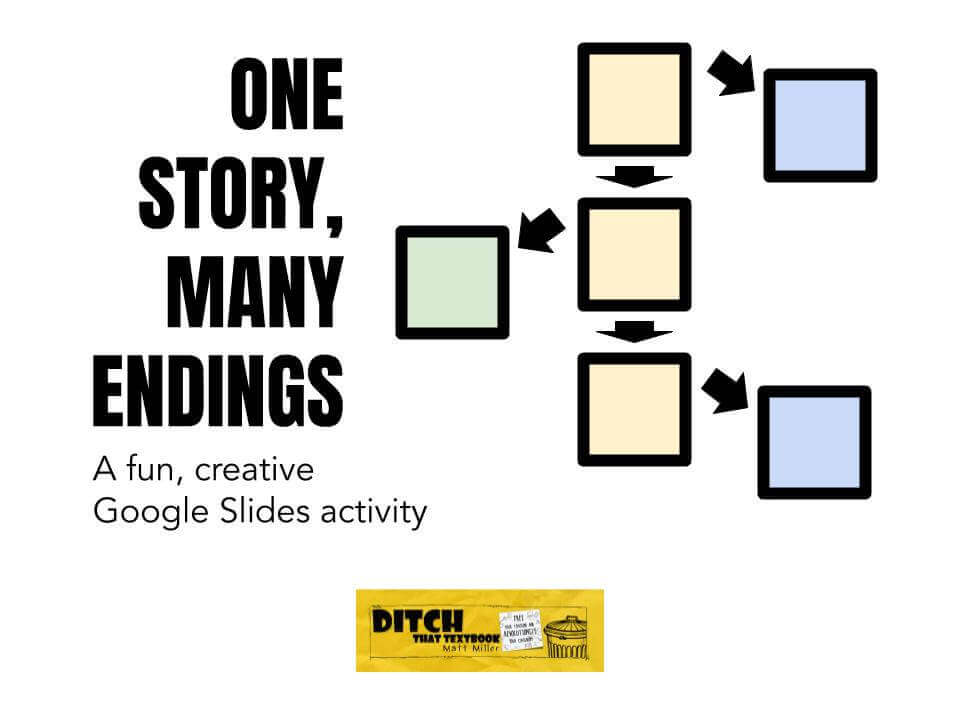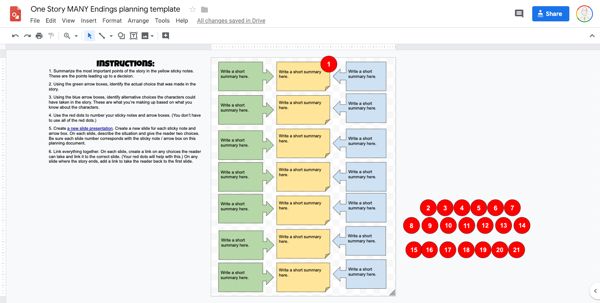
When students create new endings to a story, they demonstrate what they know — and deeper thinking begins to soar!
Reading a story as a class is great. It transports everyone to a different world, to a different time, with a different set of characters.
Solo reading is great for the same reasons.
We learn great life lessons we can take with us for years — sometimes forever — from a good story.
But we don’t just want to read the story and be done with it. There’s so much more learning and thinking that can be done!
That’s where the “One Story, MANY Endings” activity comes into play!
Check out the finished (albeit very brief) version of this activity below, and then see how to recreate it yourself in this post! (Can’t see the embedded slides below? Click here!)
(DISCLAIMER: No judgment on my lack of understanding of Harry Potter … I made this slide deck after having read the book once, watched the movie a few times and recalled what I could with a summary article on the Internet!) 🙂
Links to all of the templates used in this post. (Feel free to copy them into your Google Drive!)
- Blank planning document
- Harry Potter planning document
- Blank template with all slides linked together
- Harry Potter example story (slides linked)
What’s the idea behind this activity?
When we read a story (or anything like a story, i.e. current events, historical events, etc.), the facts and details surrounding the story are one part of it.
The big picture life lessons we take away from it are another.
But deeper critical thinking can come when we think long and hard about the characters and events — and what might have happened otherwise.
When students create new endings for a story/event they’ve learned about, lots of powerful learning happens.
It lets students use their creative capacities AND demonstrate deep understanding of what they’ve read.
Plus, it can touch on all levels of Webb’s Depth of Knowledge (DoK) …
- DoK Level 1 (recall and reproduction, the details of the story).
- DoK Level 2 (basic application of skills/concepts, the “how” of the story)
- DoK Level 3 (strategic thinking, why they acted, cause/effect)
- DoK Level 4 (extended thinking, what would happen if …)
Here’s the bonus benefit from doing this activity. It promotes computational thinking, a key skill in coding and computer science. It works on conditions, and when students understand those, that will serve them in almost anything they do in computer science!
Whoa … creativity, deep thinking and computational thinking … all in one activity? You bet!
How does this activity work?
The One Story, MANY Endings activity works well with the slide linking capabilities of Google Slides. (Yep, PowerPoint has them, too!) I wrote all about the powers of slide linking and how to do it in this post.
Here’s how to do the One Story, MANY Endings activity …
1. Pick a story or event. Read it. Study it. Understand it.
2. Using a sheet of paper (or a Google Drawing), chart out some of the most important events from the story. Then, identify choices the characters actually took (green) AND alternative choices that the characters could have taken based on what we know about them (blue).
Your students can use the planning document I created with Google Drawings! Click on the image below to copy it into your Google Drive.
3. Use the red numbered dots to help organize the slides students are about to create. Drag the red dots to the first yellow sticky note, then the first green arrow (what happened), then the first blue arrow (alternative). Then repeat.
Here’s what mine looked like when charting out Harry Potter and the Sorcerer’s Stone. (Click the image to see text more closely.)
4. Create a new slide presentation. (Easy trick: go to slides.new.)
NOTE: For the following steps, I’ve written a whole blog post explaining the power of linking from slides to slides. Check that post out if you get stuck or if you want to learn more!
5. Create the first slide based on what’s in the yellow sticky note (with the red dot with #1 on it).
6. On that slide, provide the two options for the reader to choose from: the one that actually happened (green) and the alternative choice (blue).
TIP: When you create a slide design that you like, click on its thumbnail and duplicate it (PC/Chromebook: Control + D, Mac: Command + D) and drag it where you need it again in the slide presentation. That way, you don’t have to redesign new slides every time you make a new one. (If you really want to be a Slides ninja, you can make these slide designs into master slides and add them that way.)
7. Create a slide for the choice that actually happened (green) and describe it there. Then create a slide for the alternative choice (blue) and describe it.
8. Decide what the reader does from there. Easiest option:
- If they choose the alternative choice, describe how the story would have been different with the alternative choice and make that slide a dead end where you take the reader back to the beginning of the story.
- If they choose what actually happened, give details on what actually happened and link them to the next slide (yellow sticky note), where you describe what happened in the next scene.
This can become as complex as you want! You can create a whole alternative story line for any of the alternative choices and even let the reader make choices in those. That makes the organization of the story (and the slide presentation) more complex … but if you want to do it, chart it all out and number the slides so you don’t get lost!
9. Repeat steps 5 through 8 until you’ve made it through the whole story!
How can this be used in a variety of classes?
It’s so versatile! You can use this same concept …
- in a HEALTH class to show the power of choosing healthy foods.
- in a PE class to show what happens when you make poor choices lifting weights or using good/bad strategies in different sports.
- in a SCIENCE class to show deep understanding of processes and even labs by demonstrating what would happen based on different choices.
- in a MATH class to show why incorrect steps in a math problem are incorrect and how they can be remedied
- in a FOREIGN LANGUAGE class to get repetitions on targeted vocabulary/grammar by telling stories that use them a lot
In elementary classes, this activity could be done as a group (or in small groups) where a teacher or leader fills in the blanks based on what the class says. OR students could fill in blanks in a template (click here for a blank template of my Harry Potter example that you can use).
Be creative in how you use this … it’s a GREAT way to help students understand choices and the implications of each one!
For notifications of new Ditch That Textbook content and helpful links:
- like Ditch That Textbook on Facebook
- follow @jmattmiller on Twitter
- check out the #DitchBook community on Twitter
- follow Ditch That Textbook on Pinterest
- subscribe to the Ditch That Textbook YouTube channel!
Interested in having Matt present at your event or school? Contact him by e-mail!
Matt is scheduled to present at the following upcoming events:
[getnoticed-event-table scope=”upcoming” max=”15″ expanding=”false”]





[…] Read original blog post […]